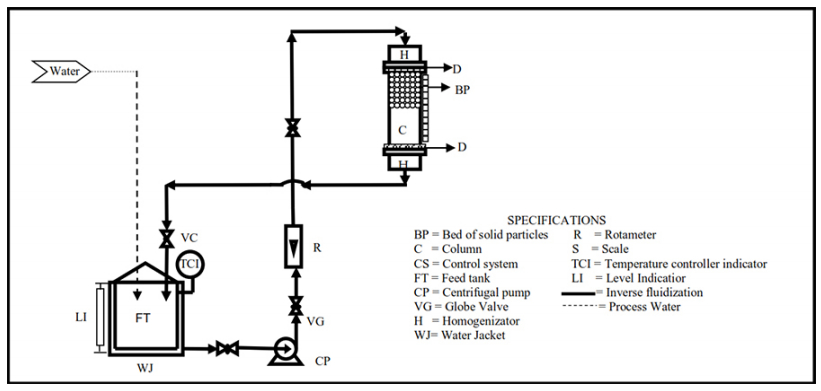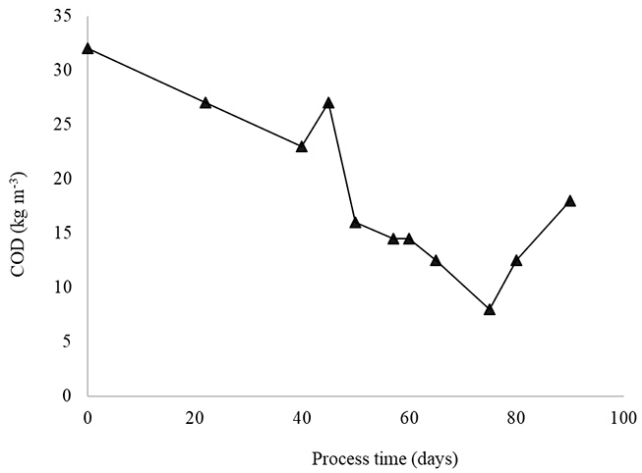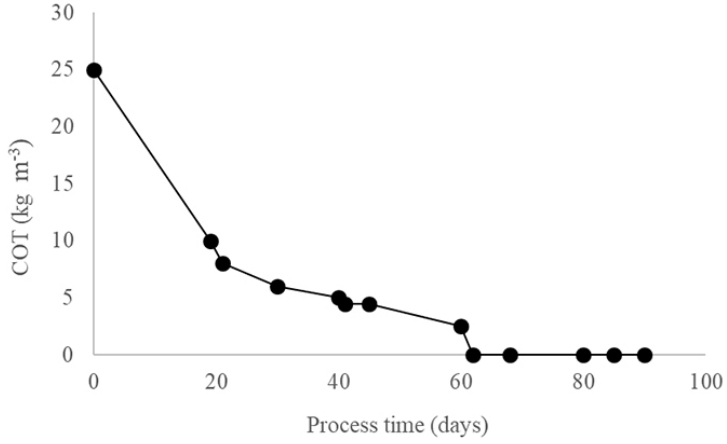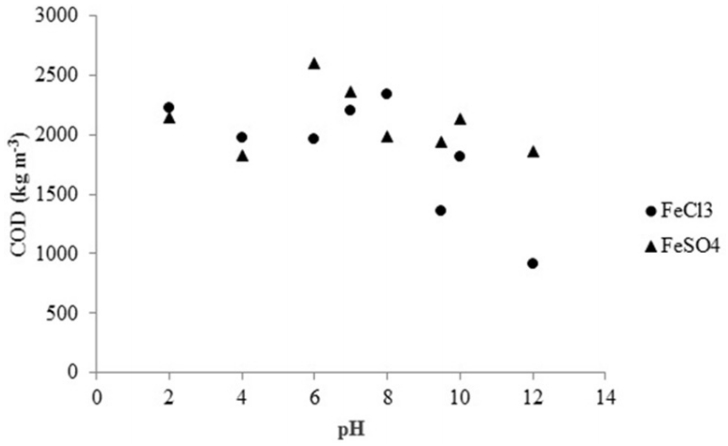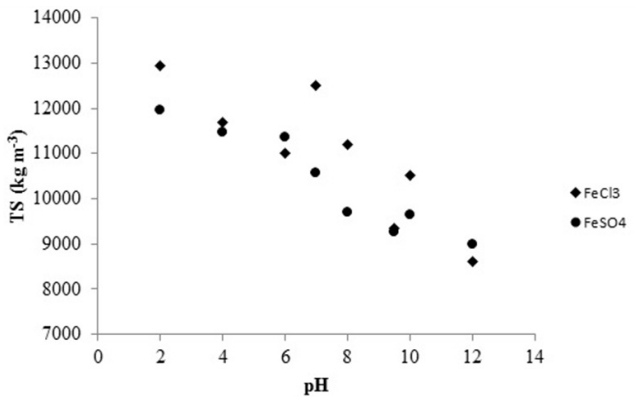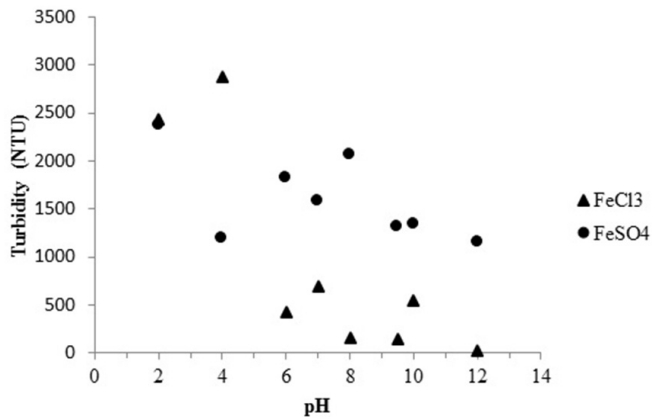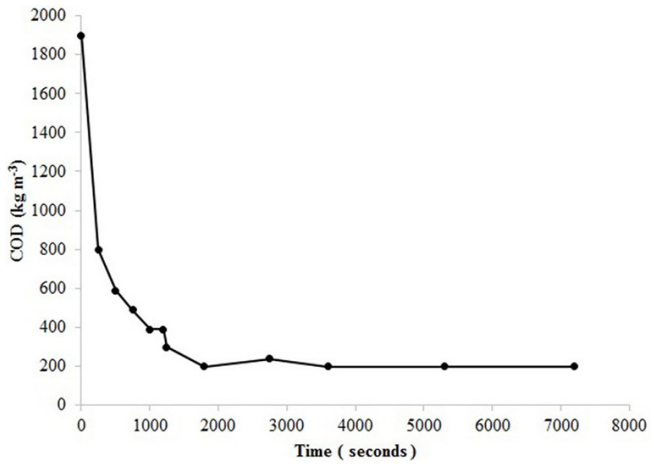1. Introduction
Vinasse is the wastewater generated by fermentation and subsequent distillation in the manufacture of ethyl alcohol [1]. It is among the most difficult waste products to dispose of because of its low pH (3–4.5), high concentrations of dissolved solids, temperature, Biochemical Oxygen Demand (BOD), and content of phenol-like (tannic and humic acids) compounds, melanoidins, and ash. Usual values of BOD and COD in vinasse range from 35 to 50 kg O2 m-3 and from 70 to 150 kg m-3 respectively [2,3,4,5]. Vinasse may also include non-volatile compounds coming from the fermentation broth, as well as phenolic and poly-phenolic compounds [6]. It has been suggested that 0.01 to 0.012 m3 of vinasse are generated for each liter of distilled ethanol produced [7]. In Mexico, distilleries are among the most important agro-industries and they are currently facing perceptible problems related to the disposal of vinasse. The production of distilled ethanol in Mexico during 2014 was 7.89 × 10-2 m3 s-1 (Tequila Regulatory Council, CRT). Uncontrolled discharge of vinasse onto land negatively impacts soil quality due to the high content of soluble salts. High temperatures and low pH seriously deteriorate soil structure, porosity, and fertility consequently producing heavy metal mobilization, pore clogging, inhibited seed germination and damaged crops [8,9,10].
Improvements on the final quality of effluents from anaerobic reactors may be achieved by combining biological and physicochemical methods. Among biological processes, inverse fluidized bed bioreactor (IFBB) processes are considered an interesting alternative for treating high load effluents because of their high mass transfer rate, minimum carryover of coated microorganism due to less solid attrition, efficient control of biofilm thickness and recovery of over coated particles at the bottom of the bed [11,13,14,15].
In terms of the physicochemical treatment, the Fenton process has attracted great interest in recent years in view of the high efficiency to generate hydroxyl radicals through decomposition of H2O2 by Fe2+ salts in acidic conditions (Eq. 1). The oxidation power is increased when the Fenton reaction is combined with radiation of the proper wavelength due to the photo-reduction of Fe3+ to Fe2+ (Eq. 2) and the generation of a catalytic cycle that involves the formation of two hydroxyl radical molecules per mole of initially decomposed H2O2. The photo-assisted process, so-called photo-assisted Fenton reaction, also shows the great advantage of working with visible light, facilitating the development of low-cost treatment procedures [16].
|
[H2O2+Fe2+®Fe3++HO−+HO∙]
|
(1)
|
|
[Fe3++H2O2+hn®Fe2++H++HO∙]
|
(2)
|
Zayas et al., 2007 [17] investigated the use of coagulation/flocculation and electrochemical oxidation processes to purify vinasse that had already been biologically treated. The coagulation/flocculation was analyzed as function of the concentration of the coagulant FeCl3 and the pH of vinasse after biological treatment, they results showed that the coagulation/flocculation removes a significant amount of COD (84%), color and turbidity (~ 99%) and the electrochemical oxidation complemented the purification of vinasse biological treatment by coagulation/flocculation to 95%.
The interest in the study and development of these systems has been increasing due to the need to reduce the environmental impact caused by liquid and solid waste from urban and industrial activities in order to achieve compliance with environmental regulations.
The main objective of this work is to achieve the highest possible removal efficiency of organic load in wastewater from ethanol distillation (vinasse) using the sequentially-coupled IFB/photo-assisted Fenton processes.
2. Materials and Method
2.1. Reagents and materials
All the reagents used in this work sulfuric acid (H2SO4, Sigma), sodium hydroxide (NaOH, Sigma), ferrous sulfate heptahydrate (FeSO4•7H2O, Sigma) and hydrogen peroxide (H2O2, 50% stabilized, Sigma) were of ACS reagent grade and used as purchased without any further purification. Polypropylene spherical particles (average diameter 3.36x10-3 m and density of 808 kg m-3) were used as support for the IFBB. The IFBB was inoculated with a microbial consortium. The microbial consortium was acclimated in vinasse and incubated at 37 ℃ ± 1 ℃ for a month. Raw vinasse samples were obtained from a distillery located in Jalisco, Mexico. Raw vinasse was characterized by measuring COD, BOD, conductivity, pH, turbidity, volatile solids, total solids, suspended solids and sediment solids (see Table 1). Potassium, calcium, magnesium were determinated by Mexican standard NMX-AA-051-SCFI-2001, copper was determinated by NMX-AA-004-SCFI-2001 and phosphate by NMX-AA-029-SCFI-2001.
Table 1. Characteristics of raw tequila vinasse.
| Parameter |
Value |
Unit |
| Turbidity |
1255 |
NTU |
| Conductivity |
14.43 × 10-2 |
S m-1 |
| Chemical Oxygen Demand (COD) |
32.3 |
kg m-3 |
| Biochemical Oxygen Demand (BOD) |
22.0 |
kg m-3 |
| Total solids (TS) |
23.25 |
kg m-3 |
| Total dissolved solids (TDS) |
18.89 |
kg m-3 |
| Suspended solids (SS) |
4.36 |
kg m-3 |
| Volatile solids |
1.58 |
kg m-3 |
| Sediment Solids |
50 |
mL/L |
| Copper |
1.45 × 10-4 |
kg m-3 |
| Potassium |
197.5 |
kg m-3 |
| Calcium |
290.9 |
kg m-3 |
| Magnesium |
173.5 |
kg m-3 |
| Phosphate |
1.19 × 10-2 |
kg m-3 |
| pH |
3.31 |
|
2.2. Inverse fluidized bed bioreactor set-up
The Inverse Fluidized Bed Bioreactor (IFBB) used in this work was made out of glass material and consisted of a tubular section or column having an internal diameter of 0.03 m and a 0.6 m total height with a conical bottom. The system was equipped with a heated circulating bath to keep the temperature of the reactor at 37 ℃. The vinasse was stored in a tank and pumped into the column using a 1/8 HP centrifugal pump (Little Giant, model 583002). The flow rate into the bioreactor was measured with a rotameter and set in the range between 1.583 × 10-5 and 1.583 × 10-3 (m3 s-1). In order to maintain the reactor pH, a solution of NaOH (0.05 N) was kept in a storage tank and dosed to the culture media storage tank by means of a peristaltic pump. The overall schematic view of the IFBB setup is shown in Figure 1.
The IFBB was fed with vinasse. The pH within the bioreactor was regulated at 6.0 ± 0.5 with 0.05 N sodium hydroxide (NaOH) during the start-up period and the temperature was kept constant at 37 ℃ ± 1 ℃ with a recirculating bath. The microbial consortium was immobilized [12] in the polypropylene particles support and it was fed into the bioreactor. Vinasse was fed at a constant flow of 1.05 × 10-5 (m3 s-1) through the inlet at the bottom of the bioreactor using a centrifugal pump. The fluidized bed bioreactor was operated for 90 days. The monitoring of the reactor was carried out by sampling the process at different time intervals to measure the decrease in organic load (COD, TOC) values.
2.3. Coagulation-flocculation
Coagulation-flocculation experiments were carried out in a test jar apparatus (Phipps & Bird) at room temperature, approximately 22 ℃. The experiment consisted of placing 2 × 10-4 m3 of vinasse biological treatment in 5 × 10-4 m3 beakers and then progressively adding 10 kg m-3 of ferrous sulfate (FeSO4) or 10 kg m-3 of ferric chloride (FeCl3) coagulants at different pH levels (2, 4, 6, 7, 8, 10 and 12) in other test jars. The samples were initially agitated at 1.66 rps for 120 seconds to obtain a perfect dispersion of the coagulant in the sample. Then, a weaker agitation of 0.1 rps for 1200 seconds was applied to promote floc formation. Samples were allowed to stand for two hours. Final pH, COD, color, total solids and turbidity were measured. COD and color were measured in a spectrophotometer Hach Model DR5000; the pH of samples was measured with a Hanna pH meter and total solids was determinated by the Mexican Standard (NMX-AA-034-SCFI-2001).
2.4. Photo-assisted fenton process
The experiments were carried out in a 1.75 × 10-4 m3 L batch fed cylindrical glass photoreactor with a slow-pressure Hg lamp (Bulbrite F6-T5BLB) able to generate a broad radiation spectrum (200–600 nm). The reactor had a concentric hole designed to introduce the lamp; 3 × 10-4 m3 of pre-treated vinasse was adjusted to pH = 3.0 with sulfuric acid (H2SO4). The vinasse was fed from a 5 × 10-4 m3 glass vessel into the photoreactor using a peristaltic pump (Masterflex, 77201-62); a magnetic stirrer was used to provide proper mixing. The pH was measured before, during and after that photo-assisted Fenton process using a pH meter (Oakton pH 510 series).
The flow rate in the photoreactor was 3.33 × 10-6 m3 s-1 FeSO4•7H2O was selected as the iron source and 2.8 × 10-3 kg of FeSO4•7H2O were added to the vinasse and allowed to dissolve in the dark for five minutes. At this time, 1.53 × 10-5 m3 of H2O2 (30% w/w) were added and the UV radiation was allowed to reach the photoreactor. The photo-assisted Fenton process was considered to start once the H2O2 dosage was added and the radiation was allowed to impinge on the photoreactor. The process was carried out at ambient temperature. Several 1.0 × 10-5 m3 -samples were collected at different times during the process (0, 60,300,600,1800,2700,3600 and 7200 seconds) in vials, neutralized to pH 7.0–8.0 with sodium hydroxide at 50% (w/w) and immediately analyzed for COD and TOC as described in section 2.4.
2.5. Analytical methods
Chemical Oxygen Demand (COD) and Total Organic Carbon (TOC) were determined by the standard photometric method APHA, 1998 [18]. Samples were digested using a thermoreactor (Hach, DR 500) and analyzed using a UV-VIS spectrophotometer (Hach, DR 5000). Turbidity was measured using a turbidimeter (Hanna, HI98703) and reported in nephelometric turbidity units (NTU); pH was measured with a pH meter (Oakton pH 510 series).
3. Results and Discussion
3.1. Raw vinasse characterization
The composition of raw vinasse is shown in Table 1. The importance of these parameters is whether the wastewater biodegradability according to the relationship BOD5/COD is > 0.5. Vinasse in this work has a ratio of 0.68 whereby it is considered highly biodegradable. This means that the biological process is applicable to this wastewater. In Mexico there is still no general standard that specifically regulates the discharge of vinasse or the wastewater of the alcohol industry. At present, the existing environmental regulation is the Mexican Official Standard NOM-001-ECOL-1997 [20] which sets the maximum permissible limits of pollutants in wastewater discharges into national waters; in this case, the organic load maximum limit is 150 ppm.
3.2. Inverse fluidized bed bioreactor
The biomass follows the typical growth-cycle phases: in the first 20 days of the start-up operation, the COD was decreased in relation to process time; after 20 days, no significant decrease in COD was noticed. This is known as phase lag (latency) and is attributed to the time in which the microorganisms are adapted to growth conditions (carbon source or substrate, pH and temperature). Days 21 to 60 found a significant biomass increase (exponential growth phase) which was responsible for the COD decrease to 14 kg m-3.
After day 45, a peak is observed; this peak was attributed to glucose addition since the microorganisms reached a stationary phase with slow degradation. Then the COD began to decrease more slowly on day 60 because the maximum size of population was reached (stationary phase) and the raw vinasse reached 8.6 kg m-3 as seen in Figure 2. Finally, from day 61 until day 75, a decline in the biomass took place (death phase of microorganisms). After day 75 raw tequila vinasse was added to the process, with this an increase of COD is observed and this value no longer decreases, this confirms that the biomass has reached the steady state.
The organic matter degradation can also be determined using the TOC concentration present in raw vinasse. Figure 3 shows an initial TOC concentration of 24.47 kg m-3. This was reduced to 100% in the 65 day process. Samples were taken up to day 90 which confirmed that, at the end of the process, TOC was not present since the microbial consortium did not have the sufficient carbon source in the raw vinasse to continue the degradation.
This biological process presents several advantages in COD and TOC removal efficiency in a short time period. Other processes such as the one described by Arnaiz et al., 2005 [21] achieved TOC removal efficiency rates between 70 and 92% and 78 to 87% of COD removal in 117 days of operation at a laboratory scale in an inverse fluidized bed bioreactor. Another process, an anaerobic inverse fluidized bed reactor process proposed by Alvarado et al.,
[22], was used for organic matter removal in brewery wastewater with a low COD (10 kg m-3); it had COD removal efficiencies greater than 90% in a process time of up to 160 days. These authors reported COD and TOC removal between 75 and 95% respectively, using diluted vinasse or raw vinasse but with a very long processing time. In a review of literature, few authors have treated vinasse in an inverse fluidized bed bioreactor.
3.3. Coagulation-flocculation treatment
Comparison of ferrous sulfate (FeSO4) and ferric chloride (FeCl3)–Effect of pH
The pH value is a very important factor in the coagulation process. The optimum value of pH depends essentially on the properties of the water being treated and the type and concentration of the coagulant being used. Abdul et al., [24] attributed the effect of pH on the coagulation process as a balance of two competitive forces: (1) the forces between H+ and metal hydrolysis products for interaction with organic ligands that may be present in water, and (2) the forces between hydroxide ions and organic anions for interaction with metal hydrolysis products.
The coagulation-flocculation process at different pH levels has been used for total solids and turbidity removal as well as for lowering COD. The variation of the removal percentages of COD, total solids and turbidity as a function of pH is shown in Figures 4, 5 and 6. The removal percentage of COD varies from 28% to 40% for FeCl3 and varies from 31% to 40% for FeSO4 in the pH range of 2 to 12; however, between pH 8 and 9.5 in FeCl3, the removal percentage of COD increases linearly, reaching a maximum value of 56%. For both total solids and turbidity, the removal percentage varied from approximately 34% to almost 99% and from 31% to 77% for FeCl3 and FeSO4 respectively at pH 12. In general, FeCl3 acts by destabilizing colloidal material, resulting in the agglomeration of the small particles into flocs. The optimal conditions of pH and coagulant dose encountered for vinasse biological pre-treatment can be satisfactorily explained by the arguments of Ching et al., , who considered that, in an aqueous solution, the hydrated metal ion (Fe3+) from the dissolution of FeCl3 is hydrolyzed to yield monomeric species of the form [Fe(H2O)6]3+, [Fe(H2O)5(OH)]2+,
[Fe(H2O)4(OH)2]+, Fe(OH)3(s) and [Fe(H2O)2(OH)4]–. The results obtained showed that ferric chloride and ferrous sulfate have similar removal efficiencies of total solids, turbidity and COD at pH 12; thus, it is likely that the coagulation-flocculation process of the biological pre-treatment of vinasse with FeCl3 at basic pH can be developed with the participation of ferric hydroxide Fe(OH)3(s) and polymeric species that favor flocculation.
3.4. Photo-assisted fenton treatment
Photo-assisted Fenton degradation of vinasse after biological and physicochemical processes was evaluated in terms of COD. The presence of suspended solids in the vinasse is a limitation in the photo-assisted Fenton process so the coagulation-flocculation is needed before the advanced oxidation process [23].
The reaction time effect on photo-assisted Fenton was tested to determine an experimental condition for further research. The COD test is based on the assumption that all the organic materials can be oxidized by the strong oxidizing agent under acidic conditions. The results of the photo-assisted Fenton process are presented in Figure 7. Most of the organic matter measured as COD was removed within the first 1500–1800 seconds of processing time. Maximum removal efficiency was observed after 60 minutes of processing; a COD value of 194 ppm was obtained.
4. Conclusion
From the collected data, we can conclude that:
1) The operation in an inverse fluidized bed bioreactor containing a microbial consortium biofilm in a polypropylene spherical particles support with a density lower than 1 showed 80% and 99% removal of Chemical Oxygen Demand and Total Organic Carbon respectively to raw vinasse with a high organic load in a resident time of 90 days.
2) Inverse fluidized bed bioreactors can reduce high organic load in vinasse in short periods of time with a well acclimated microbial consortium.
3) The use of FeCl3 is an appropriate alternative for the removal of suspended solids. The Chemical Oxygen Demand decreased 40%; total solids removal reached a rate of 35%; and there was 99% turbidity removal efficiency at pH 12.
4) The work described in this paper shows that vinasse can be degraded by photo-Fenton technologies in a homogeneous phase. A maximum degradation of 88% was achieved after a biological and physicochemical process.
5) Other authors have treated raw vinasse using other simple and coupled processes but have failed to reduce the organic load to 200 ppm; the process outlined in this paper is significant because the organic load has decreased to 194 ppm.
6) In Mexico there is still no standard that specifically regulates the discharge of vinasse; the applicable environmental regulation is NOM-001-ECOL-1997 [20], which sets the maximum permissible limits of pollutants in wastewater discharges to 150 ppm. With the coupled processes (inverse fluidized bed bioreactor and photo-Fenton) described in this paper, 94% of organic matter degradation was achieved for undiluted vinasse.
Acknowledgments
The authors wish to express their gratitude to the National Polytechnic Institute of Mexico (IPN), the Civil Engineering Laboratory of the School of Engineering and Sciences at the University of the Americas, Puebla (UDLAP), and the Mexican National Council of Science and Technology (CONACYT).
Conflict of Interest
All authors declare no conflict of interest in this review.









 DownLoad:
DownLoad: 